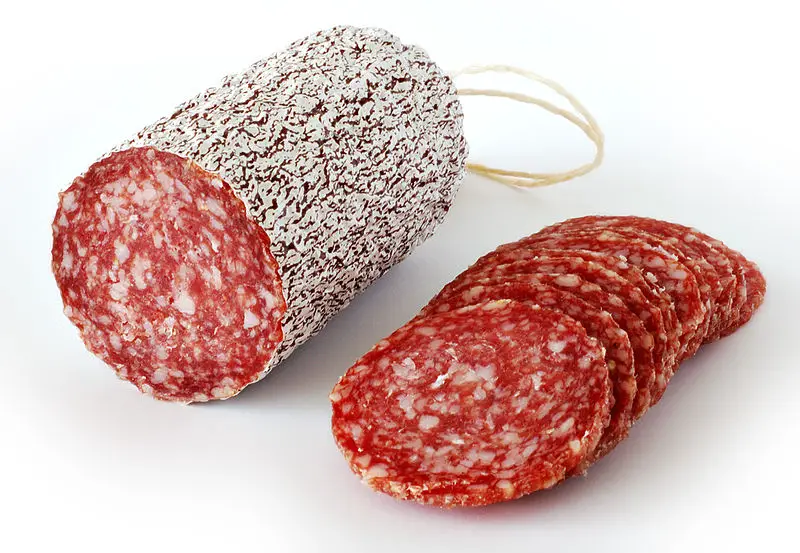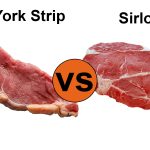Are you a fan of salami? If so, have you ever stopped to consider the difference between Genoa salami and hard salami? Depending on what country you’re from, or even where your grocery store is located, these two kinds of salami can appear remarkably different.
Whether it’s their ingredient list that set them apart or how they are served, understanding exactly what makes each one distinct will help ensure an enjoyable experience every time. In this blog post we will look at the differences between Genoa Salami and Hard Salami in order to determine which one might be best for any given occasion let’s find out!
The History of Salami

Genoa salami originated in the Italian city of Genoa, hence its name. It is a variant of the traditional dry cured sausage which was first made during ancient Roman times. The typical ingredients include pork, salt, garlic and red wine. It is firmer than other types of salami and has a stronger flavor with hints of garlic and pepper.
Hard Salami on the other hand is a smoked type of salami that comes from Central Europe. In this variety the meat is pressed into a casing, then smoked over smoldering hardwoods to give it a unique flavor and texture. Hard salami typically contains beef as well as pork, along with spices such as caraway seeds or coriander for additional flavoring.
What Is Genoa Salami?
Genoa salami is an Italian dry-cured sausage that is made from pork, salt, garlic and red wine. The meat is ground up before being stuffed into a casing and left to cure for several weeks. It has a firm texture and strong flavor with hints of garlic and pepper. Genoa salami can be served as part of cold cuts platters or added to sandwiches for extra flavor.
Genoa Salami: Nutritional Value:
– Calories: 120
– Protein: 9g
– Fat: 10g
– Carbohydrates: 0.8g
– Sodium: 730mg
– Cholesterol: 25mg
Genoa salami is a type of cured and fermented sausage made with pork. It originated in Genoa, Italy and is now enjoyed around the world. It has a slightly sweet flavor that comes from being seasoned with red wine and spices like garlic, nutmeg, and clove. Genoa salami pairs well with cheeses and other Italian meats for an impressive charcuterie board. While it can also be cooked into dishes like pasta sauces or pizzas, it’s most often served cold as part of a sandwich or salad. As with hard salami, Genoa salami should be enjoyed in moderation as part of a balanced diet.
Note: Nutritional values taken from USDA National Nutrient Database for Standard Reference (2020).
What Is Hard Salami?
Hard salami is a smoked type of salami that comes from Central Europe. Pork and beef are typically used in the production of hard salami, which may also contain spices such as caraway seeds or coriander for additional flavoring. After stuffing the mixture into a casing, it is then smoked over smoldering hardwoods. This gives the salami a unique flavor and texture that sets it apart from other types of salami. Hard salami can be served as part of cold cuts platters, added to sandwiches or enjoyed on its own.
Hard Salami Nutritional Value:
– Calories: 110
– Protein: 8g
– Fat: 8g
– Carbohydrates: 0.9g
– Sodium: 740mg
– Cholesterol: 25mg
Hard salami is a type of cured and fermented sausage made with pork and beef. It has been popular in Italy for centuries, but it’s also widely enjoyed in America as part of the classic Italian deli sandwich. Hard salami is usually eaten cold, although it can be used to add flavor to cooked dishes like pasta or pizza. Because it’s high in protein and fat, hard salami should be enjoyed in moderation as part of a balanced diet. However, its flavorful taste makes it worth the occasional indulgence!
What Is The Difference Between Genoa Salami and Hard Salami?
On a visual level, the difference between these two types of salami is quite apparent. Genoa salami has an elongated shape while hard salami is usually more short and wide. When it comes to texture, you can expect a softer consistency with Genoa salami, due to its higher fat content. Hard salami on the other hand has a firmer texture as a result of its smoking process.
In terms of flavor, Genoa salami tends to be spicier and more flavorful than hard salami which typically has an earthier taste. Additionally, hard salamis often contain additional spices that give it a slightly smoky flavor.
6 Key Differences Between Genoa Salami and Hard Salami:
1. Shape: Genoa salami is usually long and narrow while hard salami is short and wide.
2. Texture: Genoa salami has a softer consistency due to its higher fat content, while hard salami has a firmer texture from the smoking process.
3. Flavor: Genoa salami tends to be spicier with an intense flavor, while hard salami has a more earthy taste with hints of smoky flavors from additional spices.
4. Ingredients: Genoa salami is usually made with pork, while hard salamis contain both pork and beef.
5. Processing: Hard salamis are smoked over smoldering hardwood giving them their unique flavor and texture, whereas Genoa salamis are cured and fermented.
6. Nutritional Value: Although both types of salami contain high amounts of fat and cholesterol, hard salami is slightly higher in calories, protein, sodium and carbohydrates than Genoa salami.
Note: Nutritional values taken from USDA National Nutrient Database for Standard Reference (2020).
Genoa Salami Vs Hard Salami: Which Is Better?
Both Genoa salami and hard salami have their merits when it comes to taste and overall enjoyment. When choosing which one might be best suited for you, consider the occasion and what type of food or dish you’re looking to create. Genoa salami is much firmer in texture than hard salami and has a stronger garlic flavor with hints of pepper, making it ideal for adding an extra punch to your sandwiches or charcuterie platters. Hard salami is a great choice for adding a smokier flavor to dishes, such as pizza or pasta sauces. Whichever one you choose, it’s sure to be delicious!
Which One Is Right For You?
Whether you’re looking for a light snack or an ingredient for your favorite sandwich, the type of salami you choose can make all the difference. Genoa salami is great for adding flavor to dishes such as pizzas, pastas or salads, while hard salamis are best used in cold cuts and sandwiches. Ultimately it all comes down to personal preference so experiment with both kinds and see which one suits your taste buds best!
What Are the Benefits of Eating Salami?
Although it should be enjoyed in moderation due to its high fat content, there are some benefits associated with eating salami. One major benefit is that it’s full of flavor without being overly unhealthy. Salami can also be a great source of protein and other essential vitamins and minerals such as iron, B-vitamins, and zinc. Additionally, the fermentation process used in salami production creates beneficial bacteria which can help to aid digestion. Lastly, its convenience makes it a great option for quick snacks or meal additions.
What About Dry Salami vs Hard Salami?
Dry salami is a type of hard salami that has been air-dried for several weeks. Unlike its wet counterpart, dry salami does not require refrigeration and can be enjoyed without cooking. Its flavor is also more concentrated due to the lack of moisture, giving it an intense salty and tangy taste. Hard salami on the other hand still requires refrigeration after opening and is typically softer in texture. Both are delicious in their own right but which one you choose ultimately comes down to personal preference.
What To Look For In Salami
When buying salami, it’s important to pay attention to the ingredients and make sure that you are getting a high quality product. Look for salamis made with all-natural ingredients such as pork and beef, rather than those that contain fillers or preservatives. Additionally, look for ones labeled “uncured” or “no nitrates added” which indicates that they have not been treated with any chemicals or artificial substances. Finally, check the label for nutritional information such as fat content and calories per serving size so you can make an informed decision about what you are consuming.
Increasing the Shelf Life of your Salami
Salami is a great option for snacking, but it can go bad quickly if not stored correctly. To ensure the quality and safety of your salami, refrigerate it as soon as you get home from the store and consume within two weeks. If you’re looking to preserve your salami for longer periods of time, freezing is an option. Simply wrap it tightly in plastic wrap or aluminum foil before popping into the freezer where it will last up to 6 months.
How to Store Genoa Salami and Hard Salami?
Genoa salami and hard salami should both be stored in the refrigerator. Ensure that they are kept in a tightly sealed container or plastic bag to keep out moisture, air and light which can cause them to spoil quickly. When not in use, store in the top shelf of your fridge where the temperature is most consistent. For best results consume within two weeks of opening.
Where to Buy Genoa Salami Vs Hard Salami Online?
Many online stores now offer a wide selection of salami for purchase. Whether you’re looking for Genoa salami or hard salami, it’s easy to find what you’re looking for at competitive prices. Many top retailers such as Amazon, Walmart and Target all have an extensive range of options available. Alternatively, specialty shops and local delis may also carry a variety of delicious salamis that you can try out.
FAQs:
Q: What is the difference between Genoa salami and hard salami?
A: The main difference between Genoa salami and hard salami is texture. Genoa salami has a softer, more buttery texture whereas hard salami is firmer with a more intense flavor. Additionally, dry salami requires no refrigeration after opening while hard salami does.
Q: Is it safe to eat raw Salami?
A: While you can consume some types of uncookedsalamis, it’s generally best to cook them before eating as this will help reduce any potential food safety hazards. If you do choose to eat raw salami, make sure that it comes from a reliable source and is stored correctly.
Q: How long can salami last in the fridge?
A: Salami typically has a shelf life of two weeks when stored in the refrigerator. If you’re looking to preserve it for longer periods, freezing is an option, where it will last up to 6 months. Alternatively, dry salami does not require refrigeration and can be kept at room temperature for several weeks.
Q: How should I store Genoa salami and hard salami?
A: Both Genoa salami and hard salami should always be stored in the refrigerator. Ensure that they are kept in a tightly sealed container or plastic bag to keep out moisture, air and light which can cause them to spoil quickly. When not in use, store in the top shelf of your fridge where the temperature is most consistent. For best results consume within two weeks of opening.
Q: What type of salami is best?
A: The best type of salami depends on your personal preferences. If you prefer a more intense, smoky flavor then hard salami is a great choice. If you’re looking for something with a softer texture and buttery taste, Genoa salami is the way to go. Additionally, look for ones labeled “uncured” or “no nitrates added” which indicates that they have not been treated with any artificial preservatives or chemicals. Finally, check the label for nutritional information such as fat content and calories per serving size so you can make an informed decision about what you are consuming.
Q: Which salami is best for sandwich?
A: When it comes to sandwiches, Genoa salami is a great choice thanks to its milder flavor and soft texture. Hard salami may also work depending on the other ingredients in the sandwich – if you’re looking for a more intense flavor then hard salami can be a good option. Alternatively, dry salamis like pepperoni or soppressata are also popular choices for sandwiches due to their robust flavor and portability. Ultimately, the best salami for your sandwich depends on personal preference, so experiment to find which type of salami suits your taste buds!
Q: Which salami is the healthiest?
A: When it comes to health benefits, dry salami is the most nutritious option. This is because it does not require added nitrates for preservation and contains a much lower fat content compared to Genoa or hard salamis. Additionally, when choosing any type of salami, look for ones labeled “uncured” or “no nitrates added” which indicates that they have not been treated with any artificial preservatives or chemicals. Finally, check the label for nutritional information such as fat content and calories per serving size so you can make an informed decision about what you are consuming.
Q: What is the shelf life of salami?
A: Salami typically has a shelf life of two weeks when stored in the refrigerator. If you’re looking to preserve it for longer periods, freezing is an option, where it will last up to 6 months. Alternatively, dry salami does not require refrigeration and can be kept at room temperature for several weeks. Whatever type of salami you choose, make sure to store it in a tightly sealed container or plastic bag to keep out moisture, air and light which can cause them to spoil quickly. Finally, always check the label on the packaging to determine its shelf life so that you know when the product has gone bad. By following these guidelines you can ensure that your salami remains safe and tasty!
Conclusion
When it comes to salami, there are two distinct categories that vary in taste and texture: Genoa salami and hard salami. Genoa salami has a firm texture with strong garlic and pepper flavors, while hard salami has been smoked over smoldering hardwoods creating an intense smoky flavor. Depending on the occasion, either can make for an excellent addition to any dish or sandwich. So when choosing which type of salami to enjoy, keep these differences in mind and you’ll be sure to be pleased!

William Lariviere is a chef and restaurateur with over 25 years of experience in the food industry. He is the owner and operator of Swartzsdeli.com, an online restaurant that specializes in gourmet sandwiches and salads, grill & smoke. He likes to share experience, food, recipes cooking knowledge as well as reviews about restaurant and kitchen products.
William’s goal is to provide his customers with healthy, delicious food that is also affordable and develop Swartzsdeli.com into a comprehensive information site specializing in cooking and cuisine to a new level to help reach a wide range of housewives and readers.








